[English] 日本語
 Yorodumi
Yorodumi- PDB-3fqt: Phosphorylation of self-peptides alters Human Leukocyte Antigen C... -
+ Open data
Open data
- Basic information
Basic information
| Entry | Database: PDB / ID: 3fqt | ||||||
|---|---|---|---|---|---|---|---|
| Title | Phosphorylation of self-peptides alters Human Leukocyte Antigen Class I-restricted antigen presentation and generates tumor specific epitopes | ||||||
 Components Components |
| ||||||
 Keywords Keywords |  IMMUNE SYSTEM / IMMUNE SYSTEM /  PHOSPHORYLATION / PHOSPHORYLATION /  Glycoprotein / Glycoprotein /  Immune response / Immune response /  Membrane / MHC I / Membrane / MHC I /  Phosphoprotein / Phosphoprotein /  Transmembrane / Disease mutation / Transmembrane / Disease mutation /  Immunoglobulin domain / Immunoglobulin domain /  Pyrrolidone carboxylic acid / Pyrrolidone carboxylic acid /  Secreted / Secreted /  cancer / TCR / self-epitope cancer / TCR / self-epitope | ||||||
| Function / homology |  Function and homology information Function and homology informationpositive regulation of G2/MI transition of meiotic cell cycle /  oocyte maturation / female meiosis I / T cell mediated cytotoxicity directed against tumor cell target / positive regulation of memory T cell activation / TAP complex binding / Golgi medial cisterna / Deregulated CDK5 triggers multiple neurodegenerative pathways in Alzheimer's disease models / positive regulation of CD8-positive, alpha-beta T cell activation / CD8-positive, alpha-beta T cell activation ...positive regulation of G2/MI transition of meiotic cell cycle / oocyte maturation / female meiosis I / T cell mediated cytotoxicity directed against tumor cell target / positive regulation of memory T cell activation / TAP complex binding / Golgi medial cisterna / Deregulated CDK5 triggers multiple neurodegenerative pathways in Alzheimer's disease models / positive regulation of CD8-positive, alpha-beta T cell activation / CD8-positive, alpha-beta T cell activation ...positive regulation of G2/MI transition of meiotic cell cycle /  oocyte maturation / female meiosis I / T cell mediated cytotoxicity directed against tumor cell target / positive regulation of memory T cell activation / TAP complex binding / Golgi medial cisterna / Deregulated CDK5 triggers multiple neurodegenerative pathways in Alzheimer's disease models / positive regulation of CD8-positive, alpha-beta T cell activation / CD8-positive, alpha-beta T cell activation / positive regulation of CD8-positive, alpha-beta T cell proliferation / CD8 receptor binding / positive regulation of cytokinesis / antigen processing and presentation of exogenous peptide antigen via MHC class I / oocyte maturation / female meiosis I / T cell mediated cytotoxicity directed against tumor cell target / positive regulation of memory T cell activation / TAP complex binding / Golgi medial cisterna / Deregulated CDK5 triggers multiple neurodegenerative pathways in Alzheimer's disease models / positive regulation of CD8-positive, alpha-beta T cell activation / CD8-positive, alpha-beta T cell activation / positive regulation of CD8-positive, alpha-beta T cell proliferation / CD8 receptor binding / positive regulation of cytokinesis / antigen processing and presentation of exogenous peptide antigen via MHC class I /  phosphoprotein phosphatase activity / endoplasmic reticulum exit site / antigen processing and presentation of endogenous peptide antigen via MHC class I via ER pathway, TAP-dependent / TAP binding / phosphoprotein phosphatase activity / endoplasmic reticulum exit site / antigen processing and presentation of endogenous peptide antigen via MHC class I via ER pathway, TAP-dependent / TAP binding /  protection from natural killer cell mediated cytotoxicity / protection from natural killer cell mediated cytotoxicity /  beta-2-microglobulin binding / Cyclin A/B1/B2 associated events during G2/M transition / detection of bacterium / beta-2-microglobulin binding / Cyclin A/B1/B2 associated events during G2/M transition / detection of bacterium /  T cell receptor binding / Cyclin A:Cdk2-associated events at S phase entry / positive regulation of G2/M transition of mitotic cell cycle / positive regulation of mitotic cell cycle / T cell receptor binding / Cyclin A:Cdk2-associated events at S phase entry / positive regulation of G2/M transition of mitotic cell cycle / positive regulation of mitotic cell cycle /  protein-tyrosine-phosphatase / antigen processing and presentation of endogenous peptide antigen via MHC class I via ER pathway, TAP-independent / antigen processing and presentation of endogenous peptide antigen via MHC class Ib / positive regulation of ferrous iron binding / positive regulation of transferrin receptor binding / positive regulation of receptor binding / early endosome lumen / Nef mediated downregulation of MHC class I complex cell surface expression / DAP12 interactions / negative regulation of receptor binding / protein-tyrosine-phosphatase / antigen processing and presentation of endogenous peptide antigen via MHC class I via ER pathway, TAP-independent / antigen processing and presentation of endogenous peptide antigen via MHC class Ib / positive regulation of ferrous iron binding / positive regulation of transferrin receptor binding / positive regulation of receptor binding / early endosome lumen / Nef mediated downregulation of MHC class I complex cell surface expression / DAP12 interactions / negative regulation of receptor binding /  protein tyrosine phosphatase activity / lumenal side of endoplasmic reticulum membrane / Endosomal/Vacuolar pathway / Antigen Presentation: Folding, assembly and peptide loading of class I MHC / cellular response to iron(III) ion / antigen processing and presentation of exogenous protein antigen via MHC class Ib, TAP-dependent / negative regulation of forebrain neuron differentiation / ER to Golgi transport vesicle membrane / protein tyrosine phosphatase activity / lumenal side of endoplasmic reticulum membrane / Endosomal/Vacuolar pathway / Antigen Presentation: Folding, assembly and peptide loading of class I MHC / cellular response to iron(III) ion / antigen processing and presentation of exogenous protein antigen via MHC class Ib, TAP-dependent / negative regulation of forebrain neuron differentiation / ER to Golgi transport vesicle membrane /  regulation of erythrocyte differentiation / peptide antigen assembly with MHC class I protein complex / response to molecule of bacterial origin / regulation of iron ion transport / MHC class I peptide loading complex / HFE-transferrin receptor complex / T cell mediated cytotoxicity / cellular response to iron ion / antigen processing and presentation of endogenous peptide antigen via MHC class I / positive regulation of T cell cytokine production / MHC class I protein complex / multicellular organismal-level iron ion homeostasis / negative regulation of neurogenesis / peptide antigen assembly with MHC class II protein complex / regulation of erythrocyte differentiation / peptide antigen assembly with MHC class I protein complex / response to molecule of bacterial origin / regulation of iron ion transport / MHC class I peptide loading complex / HFE-transferrin receptor complex / T cell mediated cytotoxicity / cellular response to iron ion / antigen processing and presentation of endogenous peptide antigen via MHC class I / positive regulation of T cell cytokine production / MHC class I protein complex / multicellular organismal-level iron ion homeostasis / negative regulation of neurogenesis / peptide antigen assembly with MHC class II protein complex /  spindle pole / positive regulation of receptor-mediated endocytosis / MHC class II protein complex / cellular response to nicotine / positive regulation of T cell mediated cytotoxicity / recycling endosome membrane / specific granule lumen / phagocytic vesicle membrane / peptide antigen binding / positive regulation of cellular senescence / antigen processing and presentation of exogenous peptide antigen via MHC class II / negative regulation of epithelial cell proliferation / G2/M transition of mitotic cell cycle / Immunoregulatory interactions between a Lymphoid and a non-Lymphoid cell / Interferon gamma signaling / positive regulation of immune response / Modulation by Mtb of host immune system / positive regulation of type II interferon production / Interferon alpha/beta signaling / sensory perception of smell / positive regulation of T cell activation / positive regulation of protein binding / tertiary granule lumen / E3 ubiquitin ligases ubiquitinate target proteins / DAP12 signaling / negative regulation of neuron projection development / MHC class II protein complex binding / late endosome membrane / mitotic cell cycle / T cell differentiation in thymus / T cell receptor signaling pathway / ER-Phagosome pathway / iron ion transport / early endosome membrane / protein refolding / antibacterial humoral response / protein homotetramerization / intracellular iron ion homeostasis / amyloid fibril formation / learning or memory / defense response to Gram-positive bacterium / spindle pole / positive regulation of receptor-mediated endocytosis / MHC class II protein complex / cellular response to nicotine / positive regulation of T cell mediated cytotoxicity / recycling endosome membrane / specific granule lumen / phagocytic vesicle membrane / peptide antigen binding / positive regulation of cellular senescence / antigen processing and presentation of exogenous peptide antigen via MHC class II / negative regulation of epithelial cell proliferation / G2/M transition of mitotic cell cycle / Immunoregulatory interactions between a Lymphoid and a non-Lymphoid cell / Interferon gamma signaling / positive regulation of immune response / Modulation by Mtb of host immune system / positive regulation of type II interferon production / Interferon alpha/beta signaling / sensory perception of smell / positive regulation of T cell activation / positive regulation of protein binding / tertiary granule lumen / E3 ubiquitin ligases ubiquitinate target proteins / DAP12 signaling / negative regulation of neuron projection development / MHC class II protein complex binding / late endosome membrane / mitotic cell cycle / T cell differentiation in thymus / T cell receptor signaling pathway / ER-Phagosome pathway / iron ion transport / early endosome membrane / protein refolding / antibacterial humoral response / protein homotetramerization / intracellular iron ion homeostasis / amyloid fibril formation / learning or memory / defense response to Gram-positive bacterium /  immune response immune responseSimilarity search - Function | ||||||
| Biological species |   Homo sapiens (human) Homo sapiens (human) | ||||||
| Method |  X-RAY DIFFRACTION / X-RAY DIFFRACTION /  MOLECULAR REPLACEMENT / Resolution: 1.8 Å MOLECULAR REPLACEMENT / Resolution: 1.8 Å | ||||||
 Authors Authors | Petersen, J. / Rossjohn, J. | ||||||
 Citation Citation |  Journal: Proc.Natl.Acad.Sci.Usa / Year: 2009 Journal: Proc.Natl.Acad.Sci.Usa / Year: 2009Title: Phosphorylated self-peptides alter human leukocyte antigen class I-restricted antigen presentation and generate tumor-specific epitopes Authors: Petersen, J. / Wurzbacher, S.J. / Williamson, N.A. / Ramarathinam, S.H. / Reid, H.H. / Nair, A.K. / Zhao, A.Y. / Nastovska, R. / Rudge, G. / Rossjohn, J. / Purcell, A.W. | ||||||
| History |
|
- Structure visualization
Structure visualization
| Structure viewer | Molecule:  Molmil Molmil Jmol/JSmol Jmol/JSmol |
|---|
- Downloads & links
Downloads & links
- Download
Download
| PDBx/mmCIF format |  3fqt.cif.gz 3fqt.cif.gz | 182.6 KB | Display |  PDBx/mmCIF format PDBx/mmCIF format |
|---|---|---|---|---|
| PDB format |  pdb3fqt.ent.gz pdb3fqt.ent.gz | 143.1 KB | Display |  PDB format PDB format |
| PDBx/mmJSON format |  3fqt.json.gz 3fqt.json.gz | Tree view |  PDBx/mmJSON format PDBx/mmJSON format | |
| Others |  Other downloads Other downloads |
-Validation report
| Arichive directory |  https://data.pdbj.org/pub/pdb/validation_reports/fq/3fqt https://data.pdbj.org/pub/pdb/validation_reports/fq/3fqt ftp://data.pdbj.org/pub/pdb/validation_reports/fq/3fqt ftp://data.pdbj.org/pub/pdb/validation_reports/fq/3fqt | HTTPS FTP |
|---|
-Related structure data
| Related structure data | 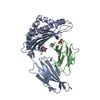 3fqnC 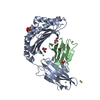 3fqrC 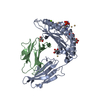 3fquC  3fqwSC  3fqxC C: citing same article ( S: Starting model for refinement |
|---|---|
| Similar structure data |
- Links
Links
- Assembly
Assembly
| Deposited unit | 
| ||||||||
|---|---|---|---|---|---|---|---|---|---|
| 1 |
| ||||||||
| Unit cell |
|
- Components
Components
-Protein , 2 types, 2 molecules AB
| #1: Protein | Mass: 31854.203 Da / Num. of mol.: 1 Fragment: EXTRACELLULAR DOMAINS ALPHA1, ALPHA2, ALPHA3, UNP residues 25-299 Source method: isolated from a genetically manipulated source Source: (gene. exp.)   Homo sapiens (human) / Gene: HLA-A, HLAA / Plasmid: pET 30 / Production host: Homo sapiens (human) / Gene: HLA-A, HLAA / Plasmid: pET 30 / Production host:   Escherichia coli (E. coli) / Strain (production host): BL21(DE3) / References: UniProt: P01892, UniProt: P04439*PLUS Escherichia coli (E. coli) / Strain (production host): BL21(DE3) / References: UniProt: P01892, UniProt: P04439*PLUS |
|---|---|
| #2: Protein |  Beta-2 microglobulin Beta-2 microglobulinMass: 11635.002 Da / Num. of mol.: 1 Source method: isolated from a genetically manipulated source Source: (gene. exp.)   Homo sapiens (human) / Gene: B2M / Plasmid: pET 30 / Production host: Homo sapiens (human) / Gene: B2M / Plasmid: pET 30 / Production host:   Escherichia coli (E. coli) / Strain (production host): BL21(DE3) / References: UniProt: P61769 Escherichia coli (E. coli) / Strain (production host): BL21(DE3) / References: UniProt: P61769 |
-Protein/peptide , 1 types, 1 molecules C
| #3: Protein/peptide | Mass: 870.029 Da / Num. of mol.: 1 / Source method: obtained synthetically / Details: synthetic peptide / References: UniProt: P30305*PLUS |
|---|
-Non-polymers , 4 types, 405 molecules 






| #4: Chemical | ChemComp-CD / #5: Chemical | ChemComp-MG / | #6: Chemical | ChemComp-GOL /  Glycerol Glycerol#7: Water | ChemComp-HOH / |  Water Water |
|---|
-Experimental details
-Experiment
| Experiment | Method:  X-RAY DIFFRACTION / Number of used crystals: 1 X-RAY DIFFRACTION / Number of used crystals: 1 |
|---|
- Sample preparation
Sample preparation
| Crystal | Density Matthews: 2.96 Å3/Da / Density % sol: 58.44 % / Mosaicity: 0.874 ° |
|---|---|
Crystal grow | Temperature: 293 K / Method: vapor diffusion, hanging drop / pH: 7.4 Details: 13% PEG3350, 3mM CdCl2, 3mM MgCl2, 0.1M NaCl, pH7.4, temperature 293K, VAPOR DIFFUSION, HANGING DROP |
-Data collection
| Diffraction | Mean temperature: 100 K |
|---|---|
| Diffraction source | Source:  ROTATING ANODE / Type: RIGAKU RUH3R / Wavelength: 1.5418 Å ROTATING ANODE / Type: RIGAKU RUH3R / Wavelength: 1.5418 Å |
| Detector | Type: RIGAKU RAXIS IV++ / Detector: IMAGE PLATE / Date: Jul 27, 2008 / Details: osmic mirrors |
| Radiation | Protocol: SINGLE WAVELENGTH / Monochromatic (M) / Laue (L): M / Scattering type: x-ray |
| Radiation wavelength | Wavelength : 1.5418 Å / Relative weight: 1 : 1.5418 Å / Relative weight: 1 |
| Reflection | Resolution: 1.8→50 Å / Num. obs: 49388 / % possible obs: 99.1 % / Redundancy: 3.5 % / Rmerge(I) obs: 0.05 / Χ2: 1.023 / Net I/σ(I): 18.618 |
| Reflection shell | Resolution: 1.8→1.86 Å / Redundancy: 3.5 % / Rmerge(I) obs: 0.45 / Mean I/σ(I) obs: 2.75 / Num. unique all: 4804 / Χ2: 1.047 / % possible all: 97.8 |
- Processing
Processing
| Software |
| ||||||||||||||||||||||||||||||||||||||||||||||||||||||||||||||||||||||||||||||||||||||||||||||||||||||||||||||||||||||||||||||
|---|---|---|---|---|---|---|---|---|---|---|---|---|---|---|---|---|---|---|---|---|---|---|---|---|---|---|---|---|---|---|---|---|---|---|---|---|---|---|---|---|---|---|---|---|---|---|---|---|---|---|---|---|---|---|---|---|---|---|---|---|---|---|---|---|---|---|---|---|---|---|---|---|---|---|---|---|---|---|---|---|---|---|---|---|---|---|---|---|---|---|---|---|---|---|---|---|---|---|---|---|---|---|---|---|---|---|---|---|---|---|---|---|---|---|---|---|---|---|---|---|---|---|---|---|---|---|---|
| Refinement | Method to determine structure : :  MOLECULAR REPLACEMENT MOLECULAR REPLACEMENTStarting model: PDB ENTRY 3FQW Resolution: 1.8→24.928 Å / Occupancy max: 1 / Occupancy min: 0 / FOM work R set: 0.877 / SU ML: 0.24 / Cross valid method: THROUGHOUT / σ(F): 1.34
| ||||||||||||||||||||||||||||||||||||||||||||||||||||||||||||||||||||||||||||||||||||||||||||||||||||||||||||||||||||||||||||||
| Solvent computation | Shrinkage radii: 0.9 Å / VDW probe radii: 1.11 Å / Solvent model: FLAT BULK SOLVENT MODEL / Bsol: 48.902 Å2 / ksol: 0.358 e/Å3 | ||||||||||||||||||||||||||||||||||||||||||||||||||||||||||||||||||||||||||||||||||||||||||||||||||||||||||||||||||||||||||||||
| Displacement parameters | Biso max: 99.69 Å2 / Biso mean: 30.625 Å2 / Biso min: 5.67 Å2
| ||||||||||||||||||||||||||||||||||||||||||||||||||||||||||||||||||||||||||||||||||||||||||||||||||||||||||||||||||||||||||||||
| Refinement step | Cycle: LAST / Resolution: 1.8→24.928 Å
| ||||||||||||||||||||||||||||||||||||||||||||||||||||||||||||||||||||||||||||||||||||||||||||||||||||||||||||||||||||||||||||||
| Refine LS restraints |
| ||||||||||||||||||||||||||||||||||||||||||||||||||||||||||||||||||||||||||||||||||||||||||||||||||||||||||||||||||||||||||||||
| LS refinement shell | Refine-ID: X-RAY DIFFRACTION / Total num. of bins used: 17
| ||||||||||||||||||||||||||||||||||||||||||||||||||||||||||||||||||||||||||||||||||||||||||||||||||||||||||||||||||||||||||||||
| Refinement TLS params. | Method: refined / Refine-ID: X-RAY DIFFRACTION
| ||||||||||||||||||||||||||||||||||||||||||||||||||||||||||||||||||||||||||||||||||||||||||||||||||||||||||||||||||||||||||||||
| Refinement TLS group |
|
 Movie
Movie Controller
Controller








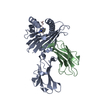







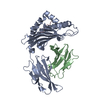
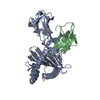
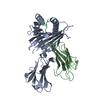


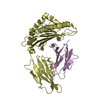
 PDBj
PDBj














